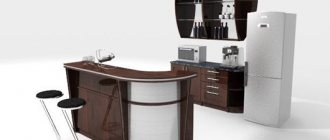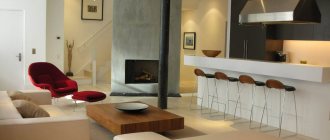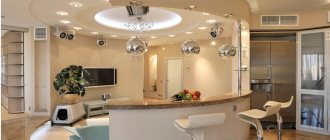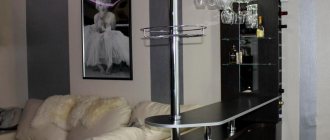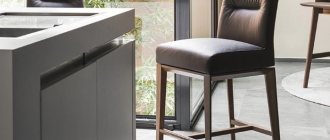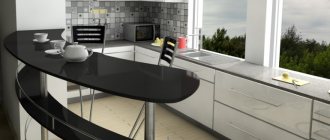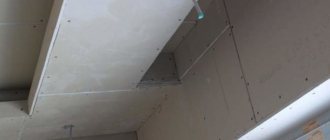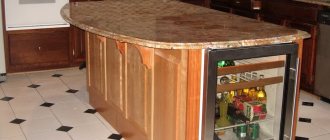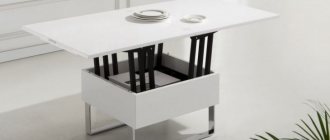In modern conditions, apartment owners strive to extract maximum functionality from every available square meter. This is caused by the rapid densification of residential buildings and mass migration of the population to large cities. A successful example of such unification is a folding transforming bar counter for the kitchen. It harmoniously combines wide functionality and allows you to diversify the standard kitchen interior.
Advantages of transformable bar counters
The folding bar counter is a modified version of the restaurant model, adapted specifically for small living spaces.
Thanks to the beneficial combination of compactness and functionality, the use of such a bar counter allows you to achieve the following advantages:
- increasing the available working surface;
- compactness and the ability to integrate into almost any interior;
- with its help you can delimit space and separate the work area from the eating area;
- in small kitchens it can act as a small folding table or a place for a tea break.
Varieties
Depending on the design features, folding bar counters for the kitchen are divided into the following groups.
Folding
They represent a beneficial combination of ergonomics, design and functionality. When folded, the folding bar counter looks like a small bedside table that functions as a table for a quick breakfast.
As a rule, it has an island arrangement, that is, it is placed separately from the main kitchen unit.
Shape and configuration
We have a fairly stable idea of a typical bar counter - an elongated but narrow surface made of stone, wood or plastic. Yes, this is the most popular and widespread option, but it is far from the only one.
For example, if the kitchen is small and the family consists of only two people, then a “standard” long bar counter is completely useless - it can easily be doubled, turning it literally into a small table.
The shapes are even more varied - it is not necessarily a narrow and long rectangle. Bar counters in the shape of a semicircle are also popular, but such exotic options require a lot of space, which is often in short supply in a corner kitchen. But in a kitchen-living room or studio this will be an excellent option for zoning space.
Support method
There are several most common bar counter configurations:
- Rectangular table top with a support leg.
The peculiarity of this type of stand is that there is free space under the tabletop. There is a pipe under the free edge that holds the bar top in place. Sometimes the pipe is extended to the floor and used as holders for various fasteners, brackets and baskets.
There are also options with two or three legs - such models resemble a regular table, but much higher.
Owners of small kitchens who want to visually expand the space and make it lighter should pay attention to this version of the bar counter.
- With storage space.
In this case, the support for the countertop is represented by bar drawers and cabinets. This option is suitable for large areas where such furniture will not look so massive. The irony is that in a large kitchen you can already find enough storage space, but tiny Khrushchev-era apartments cannot afford this.
An important point to consider is that the width of the counter must be increased to make sitting at it comfortable.
- With built-in household appliances.
The latest trend is to use a bar counter not only to store kitchen utensils, but also to integrate household appliances. Usually a hob is located here. For a small bar counter, models with only 1-2 burners are suitable.
If you have enough space, you can move an oven or corner sink to the bar counter. In the latter case, you need to be careful:
- it is necessary to think in advance where the dishes will be dried - this place should be next to the sink so that the floor around is not covered in drops and splashes;
- It is not always possible to pull communications where you want.
Size
There are no strict standards and requirements for the size of bar counters, but there are recommendations for height and width:
- 110–120 cm is the average height, you need to select bar stools for it;
- 50–60 cm is the optimal width for comfortable work or snacking;
- 30 cm is the minimum width - a narrower tabletop simply will not be used.
The height parameter is quite arbitrary, since it is selected individually for a specific kitchen:
if it is important to zone the space, then it can reach 130 cm; if the countertop continues the kitchen set, then often it will not be higher than 90 cm from the floor.
To make the bar counter as comfortable as possible, if space is possible, the width of the counter is increased to 80 cm.
Length is a factor that completely depends on the wishes of the owners:
- For some, a stand long enough for two stools will be enough;
- To others, the tabletop along the entire wall will seem small.
It is worth considering that a person needs about 55–60 centimeters to spend time comfortably.
Functional content
The bar counter itself can be called an addition to the main kitchen set. But you can also find additional elements for it - in this case, the counter will turn into a bar console.
The stand in this case will play the role of a tree to which the following can be attached:
- holders for glasses and wine glasses;
- fruit bowls;
- side serving shelf;
- carousels;
- roof rails;
- handrails;
- foot supports;
- other useful accessories.
Many housewives know about the mobility of railing systems; they can be installed in any convenient place in the kitchen, accessories can easily be moved on them. Caring for them is very simple, just wipe with a damp cloth and wipe dry.
For those who like to cook, there are swivel hangers with hooks for ladles, spatulas, spoons, and side shelves for serving. Wine and glass stands are used for guests. Spending time in such a home bar is pleasant and comfortable.
Device
A standard folding stand consists of three main elements: an upper and lower part, as well as a transforming mechanism. Let's look at each of the elements in more detail.
Upper part (table top)
A wide range of materials can be used to make countertops, such as:
- tree — when making countertops from natural wood, both budget materials (spruce, pine, larch) and more noble varieties (beech, oak, exotic species) are used. Natural solid wood can be given almost any shape, painted with carvings or decorative elements. The finished product has good performance characteristics, resistant to wear and mechanical damage;
- metal - a metal countertop will be appropriate in rooms designed in high-tech, loft or futurism style, as well as in combination with the main kitchen set made of a similar material. To make metal countertops, glossy or matte stainless steel, aluminum and even sheet copper are used. The finished tabletop is quite durable and resistant to mechanical damage. The disadvantages of a metal bar counter include unpleasant tactile sensations and poor combination with other interior solutions;
- laminated chipboard - is a modern, practical material. The base of the table top is made of chipboard. Decorative kraft paper is applied to the surface, acting as a decorative and fastening element. For protection, a layer of high-pressure plastic (overlay) is applied on top. As a result, the finished tabletop withstands mechanical damage well and is not afraid of moisture. The main advantages of a countertop made of LSDP are its decorative properties and price. The cost of material and work for this material is significantly lower than for products made from natural wood, stone or metal. And with the help of digital printing, a pattern can be applied to the surface of the chipboard that imitates wood, natural or artificial stone, or any ornament or pattern;
- MDF - differs from laminated chipboard only in the base material, which is fibreboard. Otherwise, the products have a similar production process - the base is covered with kraft paper, liquid plastic and laminated. The finished product is not resistant to impacts, scratches and excessive moisture. Using postforming, the surface can be designed to resemble natural materials or create your own unique pattern;
- a natural stone — countertops made of natural stone look very presentable, in addition, they are highly durable and durable. Due to the significant weight of the product, the use of natural stone in folding bar counters is quite problematic - for it you need to prepare a solid base;
- fake diamond - a modern composite material, texture and color imitating a natural stone panel. They are distinguished by their strength and durability, and if damaged they can be easily restored. They are considered an environmentally friendly material that does not emit harmful components. The only drawback can be considered the relatively high price, compared to other artificial materials;
- glass - a glass bar top can rightfully be considered the highlight of any interior. For its production, special high-strength glass is used, which can be: frosted;
- transparent;
- hardened;
- multi-colored with additional patterns.
A tabletop made of glass can be used in multi-level structures with other materials. It is distinguished by sufficient strength - it can only be broken with a targeted and very strong blow. This surface is not susceptible to moisture, high temperatures, or chemicals. If scratches or chips appear, it can be easily restored by polishing.
Each of the above materials has its own advantages and disadvantages, as well as requirements for care and operation.
Bottom part
The choice of material for the bottom of the bar directly depends on the countertop. First of all, it is necessary to calculate the load that will fall on the supporting structure.
For example, if the tabletop is made of metal, glass or stone, it is recommended to use metal supports. For laminated chipboard, MDF or natural wood, wooden legs are more suitable.
The design of the supports depends on the type of bar counter. Rotary models are equipped with a leg with a wheel at the bottom. Folding or folding bar counters use U-shaped or V-shaped folding supports equipped with a transforming mechanism. Using this system allows you to hide the leg under the tabletop when folded.
Transforming mechanism
Located between the top and bottom of the bar counter. Serves to move the tabletop to the “working” position. The type of mechanism used directly depends on the type of bar counter.
Roller mechanism. It is used in retractable models that are hidden under the main countertop of the kitchen unit. They are a combination of metal runners and plastic wheels.
Hinge mechanism. Used in rotary models. It consists of two metal or plastic plates with a special recess into which a bearing ball is installed.
Loop mechanism. Used in folding and folding models. The fastening scheme can be presented in two options:
- wall-tabletop;
- lower-upper parts of the bar counter.
What does the height depend on, and how to choose the optimal one?
The distance from the floor is determined largely by the type of structure. In the kitchen, this element can be either free-standing or part of a kitchen unit. Here are some possible device options.
- Continuation of the headset (stand-branch).
In this case, the height of the counter will be determined by the distance to the kitchen countertop from the floor.
As a standard, this parameter is 85 cm (with slight deviations up to 5 cm upward) if the surface has one level.
An option with a two-level design is possible.
The direction of the tabletop can be any.
In a small kitchen of 507 sq.m., for example, to save space it makes sense to use a window sill.
Advice! For a small kitchen, it is better to choose stool-type bar stools that can be pushed under the counter and free up space.
In a kitchen-living room or studio, such a model can divide the space into zones. Here, angular, linear or U-shaped headset layout options are possible.
- Stand-stand.
Island kitchen layout is a stylish and practical solution for a spacious kitchen in a private home, studio or combined kitchen-living room.
The height of the island stand here will be at the level of the working surface of the headset or at two levels.
The work surface is located on the same level as the lower cabinets, and the counter top rises higher.
With this layout, the kitchen is even more functional: the island serves as both a work surface and a dining area. There may be drawers and shelves on different sides for organizing storage.
- Freestanding.
It is not always possible to make the counter a monolithic extension of the kitchen unit. Indeed, in such cases it is necessary to make furniture to order, which increases the budget for arrangement. You can purchase it separately, choosing a design that matches your kitchen furniture.
This type of structure can be installed against the wall, thereby separating the working part of the kitchen from the dining room or living room. Then the stand will serve as a partition.
In this case, the height of the bar counter in the kitchen may not depend on the level of the countertop set from the floor, because it serves only as a partition and dining area. The standard and minimum permissible height of a dining table in the form of a counter according to GOST 13025.3-85 is 75 cm from the floor (which is optimal for a person of average height 1.65 m). Chairs for such a dining group will also be standard. You can make an option within 105-115 cm. Then you will need to purchase special high chairs.
- Stand-window sill or by the window.
It is not necessary to make a single, solid surface with the window sill. A window sill stand that is not connected to the working surface of the kitchen unit may look more compact and practical.
The height is determined by the level of the window sill. An alternative is not to touch the window sill, installing a tabletop 20-30 cm higher. Then you just need to choose the right chairs.
Below are two options for organizing a bar counter by the window: with and without removing the window sill.
- Folding mini stand.
Another optimal solution for arranging a small kitchen.
The height also corresponds to the dimensions of a regular dining table. The standard is 75 cm.
- Two-level.
This model can be implemented in any of the above options. This way you can divide the surface into dining and working; make a design that is as close as possible to the traditional, classic design of such a structure, decorating the kitchen in the style of a cafe or bar.
The height of the upper level can be determined individually, but within standard limits - up to 105-115 cm. In this case, you will not have to make custom-made chairs. The lower level corresponds to the height of the lower cabinets from the floor (85-90 cm).
Location
The design and functionality of the bar counter depends on its location in the room. From the point of view of dislocation, the following types of mobile bar counters are distinguished:
- island Located separately from the main kitchen unit. Unlike a stationary bar, it can have wheels and move freely around the room. Equipped with drawers and shelves for storing drinks and kitchen utensils;
- combined. It is a logical continuation of the main working surface. As a rule, it is performed in the same style as the main kitchen set. Depending on the material of the tabletop, it is equipped with U-shaped or V-shaped legs made of metal or wood. It is advisable to plan the manufacture of such a bar counter together with kitchen furniture;
- two-level. A distinctive feature of this modification is that the bar counter is located above or below the main working surface. It can be equipped with a retractable, roll-out, rotary mechanism or located higher, strengthened with special supports;
- wall-mounted A relatively cheap option, which consists of a table top and a transforming mechanism. Attached to the wall using self-tapping screws or dowels. When folded, it takes up virtually no free space and will fit perfectly into the interior of a small kitchen, serving as a folding bar table;
- based on the window sill. In conditions of limited space, a bar counter can be installed directly on the windowsill of the kitchen or loggia. It does not take up precious meters of free space and can be used for a small snack and a morning cup of coffee.
Materials
The tabletop itself is easiest to make to order, but you can also make it yourself from a regular MDF panel. Alternatively, the tabletop can be made of solid wood, plywood and other wood derivatives. The main thing is to process it correctly so that it looks beautiful. Composite material that resembles stone in appearance is now very popular. But it differs in lightness and low price from its natural counterpart. And that’s why countertops for bar counters are often made from it.
Semicircular bar counter in the kitchen
In some cases, the base of the rack can be made of brick, covered with tiles. Metal poles or ordinary wooden legs can also be used as support.
On a note! Sometimes you can use improvised materials to make bar counters. It is quite possible to take as a basis even pallets that are used for transporting goods.
Alternative to the kitchen table
Types (open or closed)
The closed bar counter has an island arrangement and is a cabinet equipped with drawers or shelves for storing various small items. It will look harmonious in a large room, but in a small kitchen it will look unnecessarily bulky.
At the same time, open bar counters look light and do not take up much free space. They consist of a table top, a support and a transforming mechanism.
Dimensions
Like other furniture, bar counters have certain standard dimensions, such as height and width. When ordering a stand for an individual project, you can specify any size, but it is best to adhere to generally accepted standards. Then it will be easier to select additional accessories and components.
Height
It varies in the range of 860–1300 mm, but the standard height range is 1100–1150 mm. The optimal height for an island bar counter is considered to be 1050 mm, and for one combined with a kitchen unit - 900 mm.
Read more in the article: Selecting the height of the bar counter: a complete guide
When choosing a height, you should take into account the physiological and age composition of the family, as well as the functionality of the furniture. For example, it will be difficult for elderly people and children to use a stand whose height will reach 1300 mm.
At the same time, if it is planned as an additional working surface, you should not design the height below 100 mm. Otherwise, there will be additional stress on your back when working.
Width
Depends on the functions performed. The minimum size is 300 mm, which can be used as an additional working surface for a kitchen set.
If the bar is planned as a full-fledged replacement for the dining table, its width should be from 500 mm. This width is quite enough for a full serving per person.
Length
When calculating the length of the bar counter, it is necessary to start from the dimensions of the room and the number of family members.
The generally accepted norm for space per person is 60 cm. However, when designing, it is advisable to take into account the size of each family member. This approach will help create comfortable conditions for eating and relaxing.
The total length of the rack is limited only by the amount of free space. The main thing is that the finished product fits harmoniously into the interior and does not create interference when moving.
How is the height of a dining table calculated?
The height of manufactured tables is measured from the floor to the top edge of the tabletop and ranges from 72 to 78 centimeters, and the height of the chair is measured from the floor to the seat and ranges from 40 to 45 centimeters, the ideal height is 42 cm.
How is the height of the kitchen table calculated for a specific individual? Let's use a simple and simple mathematical formula: table height = human height * 75 / 165. The number 75 is the standard height of a dining table, and 165 is the average human height in centimeters.
To calculate the height of the chair, you need to subtract from the result obtained:
- 45 cm for tall people.
- 42-43 cm for average height (close to 165 cm).
- 40 cm for short people.
If you are a person of average height, 170 cm, the formula for calculating the height of the dining table will be as follows: 170 * 75 / 165 = 77.3 cm
The height of the chair for such a person will be: 77.3 – 45 = 32.3 cm.
But in real life everything is more complicated; these are calculations for a specific person for his specific height. And a whole family will sit at the kitchen table, each family member has his own height. Even for two people, you already need to calculate the average height, and then recalculate the height of the dining table. For example, if the wife’s height is 170 cm and the husband’s height is 180 cm, we get the average height for two – 175 cm.
For it we calculate the height of the kitchen table: 175 * 75 / 165 = 79.5 cm
If your family consists of 3 or more people, then you need to calculate the average height of the entire family (add up all the heights of each family member and divide by the number of family members), and then recalculate the height of the table using the above formula.
It’s a little easier to “fight” with chairs - some of them are equipped with adjustable legs. You can also purchase special elastic pillows that are placed on the seats of chairs and add the necessary height in each specific case. Thus, their height can be artificially adjusted to the existing height of the tabletop. Then lunch for everyone present turns into a joyful and comfortable event.
What is the correct chair height for a kitchen table? What should the table be like? You shouldn’t eat and work at the same table, and here’s why – the height and height of the work table should be different. Consider the height of the kitchen table.
Selection of bar stools
When calculating the dimensions, it is important to take into account the parameters of bar stools, which differ from ordinary heights and are divided into two types - regular and folding.
The classic bar stool is practically no different from its counterpart from entertainment venues. Can be adjusted in height, have one support or four legs. Some models are equipped with additional armrests and backrest.
A folding bar stool with a backrest is a modern modification of the classic version, which has two important advantages - compactness and mobility, which are achieved by removing the rivet that connects and fixes adjacent legs. When folded, they easily fit in a pantry, balcony or other hidden place.
When choosing bar stools, you should be guided by the following tips:
- Before purchasing, you need to decide on the style, height and material of the bar counter. They must be suitable in height, harmoniously combined and create a single compositional space with the stand;
- When purchasing a wooden model, you must carefully inspect the chair for abrasions, chips or cracks. Such minor defects spoil the appearance and can lead to subsequent damage to the product;
- the transforming mechanism must be in good working order and work without squeaks or jamming;
- before purchasing, you need to decide on the number of chairs and choose a place to store them;
- if the model has several legs, they should be the same length. Even a small difference, just a few millimeters, will cause the structure to become unstable and may result in an unexpected fall.
The best choice would be furniture from proven and reliable manufacturers with a positive reputation in the market.
Advantages and disadvantages
Why are bar counters so loved by designers and ordinary customers? Because of the huge number of benefits.
- Compact and space saving. Of course, you can’t arrange a three-course dinner for five people at the bar, but most often in an ordinary apartment this is not required. The narrow, elongated tabletop will allow you to have breakfast, a snack or a quick lunch with the whole family. This type of furniture is best suited for 1-2 people.
- Versatility. The word “bar” in the name of the counter no longer reflects its functionality, since this piece of furniture can be used in almost any way: for eating, as a work surface, for storage, and so on. To make the countertop truly multifunctional, it is better to choose two-tier options.
- Zoning. Creating a visual boundary between two areas (dining and dining/living room) will be appreciated by owners of studios or kitchen-living rooms. If you approach the issue correctly, then you can use every centimeter of space as efficiently as possible (we wrote more about zoning using a bar counter in a kitchen combined with a dining room or living room here >>>).
- Manifold. Now there are so many different models of furniture on the market that finding the perfect option for yourself is not difficult at all.
The bar counter has no drawbacks as such. Rather, these factors can be called limitations that should not be forgotten. Such nuances can be called:
Not for any kitchen. It’s rare, but there are kitchens where a bar counter simply doesn’t fit - most often we’re talking about narrow and long rooms. If you put a stand there, you won’t be able to get around it.
For this reason, it is so important to think through the layout of a corner kitchen with a bar counter in advance, so that it does not turn out to be an obstacle later.
Limitation. This is again about a three-course feast for five people - this is simply impossible at a bar table
If there is a need for such dinners, then a separate dining table is simply necessary - but because of it it is not at all necessary to give up the counter.
The problem is in the details. Perhaps the owners have nothing against the bar counters themselves, but not everyone will like the chairs under them - they are much higher than the usual seats. This height may be inconvenient for children or elderly parents. And this problem can be solved - the bar tabletop can be lowered to the level of a regular table.
Design
When choosing a bar counter, you need to pay attention not only to its functionality, but also to its design. A responsible approach to choosing the style of the counter will create an atmosphere of harmony and comfort in the room.
Color
When choosing a color for a bar counter, it is customary to be guided by two options:
- classic . The countertop is selected in a similar color scheme to the kitchen unit and the surrounding space. In this case, it will harmoniously combine with the overall design idea;
- contrasting _ In this case, the overall emphasis of the interior will be shifted towards the bar counter, which, in turn, will stand out clearly against the background of the rest of the furniture group.
The first option will be more appropriate in a kitchen made of wood in a classic style. A contrasting bar counter is suitable for kitchens designed in a high-tech or avant-garde style.
Style
Classical. The stands are made of natural materials in combination with metal elements. The classic style is characterized by straight lines, smooth curves and a calm color palette.
Minimalism. Laconic and discreet design style, implying a minimum number of small details. Glass is often used as a material for making a bar counter. The color scheme is muted, without bright tones or accents.
Loft . This style involves the use of massive and bulky elements. The tabletop is made of natural wood, artificial or natural stone. The color palette is dominated by moderate and dark colors.
The Mediterranean style uses natural materials and precious woods. The surfaces are decorated with intricate carvings and high-quality decorative elements.
Useful material: Kitchen design with a bar counter - design tips and photo examples
Vanguard. A bright, rich color palette and straight lines are the distinctive features of a bar counter in the avant-garde style. It is allowed to use accent lighting to concentrate more attention on the bar area.
High tech. A modern style that uses a combination of metal and polymers. Calm color palette, with a predominance of white and gray tones. Does not imply the use of a large number of decorative elements.
Dimensions: standard and non-standard solutions
There are not many standard parameters. For individual structures, the normalized height indicators are levels of 110, 120, 125 and 130 cm. They are relevant for factory options. Typical parameters of products, in turn, include a 120-centimeter length, a height of 105 and a width of 55 cm. Unit racks are part of the furniture, their tops are usually no lower than 86 and no higher than 91 cm. The height indicator then includes the height of the base (10, 12 , 15 cm) and tabletop thickness (up to 4 cm). The difference between the general level and these values corresponds to the height of the doors (facades). The length is selected maintaining an interval of at least 0.5-0.6 m per person. At the same time, an unsuccessfully placed long counter will ruin the interior of even a very large kitchen. The situation with the width of the tabletop is much simpler: it is related to ergonomics and the need to save space. Racks can also be combined with indicators corresponding to free-standing and furniture, and simple, but with several tabletops at different levels.
Height
The height of the tabletop is selected for the tallest member of the family. As for all the options, the lowest is a regular table that imitates a counter. Its height can be 75 cm. A cabinet dependent on kitchen furniture is most often at the level of 86-88 or 91 cm. Free-standing counters have much larger dimensions - 110, 120 or 130 cm. For people of normal height, standards of 110 or 120 are suitable. The structure of the bar element can also be multi-level. For example, a working part with a height of 86 cm may be connected to the set, and the bar itself, with a height of 110 cm, may be further away. The size of the counter is affected by the thickness of the tabletop. The usual options are no thicker than 4 cm, but 6- and 8-cm ones are often made from stone. The stand can be placed higher than other working surfaces. The height of the bar area in establishments is an individual issue and depends on the overall concept.
Length
At home, you should not install bulky structures, at least not unless necessary. The length is selected in accordance with the environment and the need for seating. 2-3 more places are added to the total number of residents. In the end, at least 60 cm is laid down for everyone. Appearance plays an important role in determining the ideal length. In a large kitchen, the counter may be too short and ridiculous, and in a small kitchen it may take up a lot of usable space. In total, there are 3 harmonious length options in combination with width. For a tabletop depth of 40 cm, you need a length of 120 cm, but for 60 cm, the ideal figure is 160 or 180 cm. Thus, the dimensions include a ratio of 1 to 2.5-3. If the table serves as a separator, then the length is selected based on the minimum required space for moving between zones.
Width
First of all, take into account the configuration of the element: one-sided or two-sided. In the second case, people sit opposite each other
The permissible minimum width is set at 30 cm. At the same time, the experience of previous years and comfort rules indicate an indicator of 40 cm. The minimum dimensions in any case apply to one-sided racks. It is better to make options for two sides at least 50 cm, and ideally 65 cm. In the latter case, convenience for two will be ensured, and at the same time there will be a place for a plate in the middle of the tabletop, a cup of tea or coffee, a laptop, and there will be an opportunity for serving dishes . At the same time, an indicator greater than 70 cm is considered wide and is suggested for kitchens in which there is no need to save space. In designs of original shape, the width should be selected taking into account the distance between the edges.
Accessories
To expand functionality, rotating bar counters can be equipped with additional accessories, for example, a “carousel” mechanism or a “magic corner”.
It helps solve the problem of “dead corners” by unfolding when the rack is extended. In addition to it, the rack can be equipped with additional shelves for storing various kitchen items.
Interesting read:
Reader Julia: “The bar counter for glasses is the highlight of my kitchen interior”
“How I made a small and inconvenient kitchen into a large and functional one” - the story of our reader
Lighting
The bar counter can be decorated with the following types of lamps:
- suspended - mounted directly above the tabletop, on a special strip or directly on the ceiling. They create a soft light that accentuates the tabletop. Can be equipped with relays to control brightness;
- point - mounted on any selected surface (ceiling, wall or tabletop). Create a directional beam of light to highlight details or directed illumination of the work area;
- spots - are halogen lamps that are installed on a special rotating mechanism. Their use allows you to direct light to the desired point at any time;
- LED - LED strips are used both to create full lighting and for decorative purposes. They can change shape to adapt to the surface. Modern models are equipped with a remote control that allows you to change the brightness and color of the lighting.
